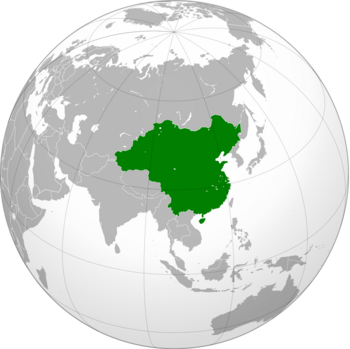Great Chinese Realm
Great Chinese Realm 大中华区 (Chinese) Da Junghua chiu (Ruoha) | |
|---|---|
| Motto: 三民主義 (Chinese) "Three Principles of the People" | |
| Anthem: | |
 Map of China during the Empire, right after the Second World War. | |
| Capital | Beijing |
| Largest city | Shanghai |
| Official languages | Standard Chinese |
| Recognised regional languages | Mongolian |
| Ethnic groups (1992) | 93.2% Han Chinese 6.8% Others |
| Demonym(s) | Chinese |
| Government | Unitary one-party presidential republic under a nationalist dictatorship (1920-1953) Unitary one-party parliamentary nationalist republic under a directorial system (1953-1956) Unitary one-party authoritarian nationalist presidential republic (1956-1990) Unitary one-party presidential republic (1991-1993) Unitary constitutional presidential republic (1993-1995) |
• President of China | First: Hu Wanjing (1920-1952) Last: Chen Jingyun (1991-1995) |
| Legislature | National Assembly |
| Formation and History | |
| 10 October, 1911 | |
• Declaration of the Republic of China | 1 January, 1912 |
• Dissolution of the Qing dynasty | 12 February, 1912 |
| 1915-1916 | |
• Great Chinese Civil Wars | 1917-1920 |
• Declaration of the Great Chinese Realm | 5 August, 1920 |
• Entrance into World War II | 8 June, 1944 |
• Death of Hu Wanjing | 2 May, 1952 |
• New Golden Age | 1958-1964 |
• Deautocratization | 1991-1994 |
• Dissolution | 5 August, 1995 |
| Area | |
• Total | 10,103,177 km2 (3,900,858 sq mi) |
| Population | |
• 1990 census | 829.7 million |
• Density | 82.12/km2 (212.7/sq mi) |
| GDP (nominal) | 1990 estimate |
• Total | $4.1 trillion |
• Per capita | $4,941 |
| HDI (1990) | 0.729 high |
| Currency | Chinese Yuan |
| Time zone | UTC+5:30 - UTC+8:30 |
| Date format | yy-mm-dd |
| Driving side | right |
| Calling code | +86 |
| ISO 3166 code | CN |
| Internet TLD | .cn |
This article is incomplete because it is pending further input from participants, or it is a work-in-progress by one author. Please comment on this article's talk page to share your input, comments and questions. Note: To contribute to this article, you may need to seek help from the author(s) of this page. |
The Empire of China (Chinese: 中华帝国; Ruohua: Jonghua deguo), officially the Great Chinese Realm (Chinese: 大中华区; Ruoha: Da Junghua chiu), was the period in Chinese history from the Fifth of August 1920 to 1995, during which China and Outer Mongolia were governed as a unitary, authoritarian one-party dictatorship by the Hanjudang. It was preceded by the Beiyang Government and Yuan Shikai's Empire of China, and was followed by the Republic of China. An authoritarian state for much of its history, the Empire rejected the Qing's idea of a multicultural China in favor of a han supremacist state.
Originating with the Han nationalist wing of the Guomindang, the Hanjudang split off from the Guomindang shortly following the proclaimation of the short-lived and unpopular Empire of China- forming its own political movement and party independent from the Guomindang. The resulting split in the Guomindang weakened their effectiveness, and the Beiyang government- far too corrupt and inefficient to achieve much, was eventually taken over by the Hanjudang, who consolidated power through a violent purge of warlords & political opponents. Hu Wanjing- at the time Chairman of the Hanjudang, established the Great Chinese Realm in 1920- and for 33 years ruled over it as a de-facto dictatorial state, with the government largely being subordinate to him. His reign saw the oppression of the numerous minoriies in China- especially the Uyghurs, Hui, and Zhuang- however it also saw an agreement with Mongolia for it to re-integrate with the rest of China as a highly autonomous region. TBC
